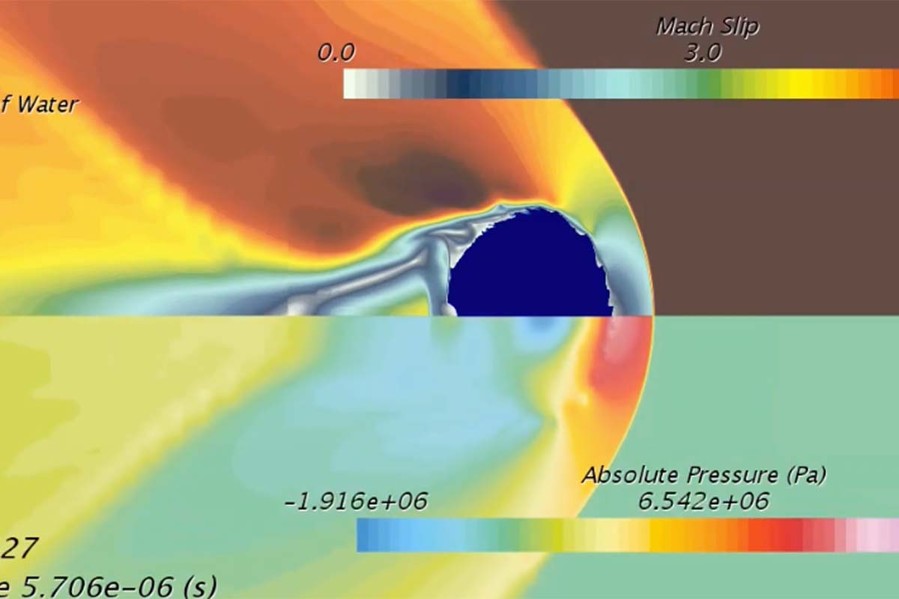University of Central Florida researchers are part of a new $1 million project funded by the Air Force Office of Scientific Research to better understand and predict how and why raindrops are affected when they cross a hypersonic shock wave.
Hypersonic speeds are those at Mach 5 and higher, or five times greater than the speed of sound. The U.S. is currently working on developing hypersonic systems for defense and travel.
The new project is important because colliding with something as light as a single raindrop could cause a lot of damage at hypersonic speeds. The work will inform researchers as to whether or not the raindrop maintains its single droplet form or breaks up into tens of much smaller droplets.
“If you have a rain droplet with a tenth of an inch diameter and you hit it at Mach 8, it can create a load as heavy as the weight of an elephant,” says Michael Kinzel, project co-investigator and an assistant professor in UCF’s Department of Mechanical and Aerospace Engineering. “So, you can’t put an elephant on the wing of an aircraft, and it’ll support it, right? It’s a huge load. And these would be hitting all over parts of the vehicle.”
Knowing the impact of different size raindrops on hypersonic aircraft and rockets will help predict when to fly, as light rainstorms may not affect travel as much as heavy storms.
The researchers want to narrow down what conditions make for safe hypersonic travel through rain. The knowledge could prevent damage and improve the accuracy of hypersonic rockets launched through rain and clouds, Kinzel says.
“This work will help lead to structural integrity when designing hypersonic vehicles,” Kinzel says. “And it develops a framework to understand how to design in that context as well as understand limitations of hypersonic flight with respect to some weather conditions.”
Kinzel will work to model the effects of raindrops on hypersonic travel by using computer simulations.
Unique test facilities combined with state-of-the-art optical and laser diagnostic systems will be used to understand the interaction of droplet and shock wave, Vasu says.
“The work is important for deterrence and the national security of the United States, and we are proud to be involved in this prestigious effort,” Vasu says. “The knowledge gained from hypersonics research could have other applications as well, including space exploration.”
Boston University is leading the project and will be working closely with Kinzel and Vasu to understand droplet behavior when impacted at hypersonic speeds. UCF will be receiving about $560,000 for the three-year project. UCF will be collaborating with engineers and scientists from the Air Force Research Laboratory and Lockheed Martin, both closely involved in the development of a variety of hypersonic vehicles.
The project further highlights UCF’s expertise in the area of hypersonic propulsion.
Kinzel received his doctorate in aerospace engineering from Pennsylvania State University and joined UCF in 2018. In addition to being a member of UCF’s Department of Mechanical and Aerospace Engineering, a part of UCF’s College of Engineering and Computer Science, he also works with UCF’s Center for Advanced Turbomachinery and Energy Research.
Vasu received his doctorate in mechanical engineering from Stanford University and joined UCF’s Department of Mechanical and Aerospace Engineering in 2012. He is a member of UCF’s Center for Advanced Turbomachinery and Energy Research, is an associate fellow of the American Institute of Aeronautics and Astronautics and a member of the International Energy Agency’s Task Team on Energy. Vasu is a recipient of DARPA’s Director’s Fellowship, DARPA Young Faculty award, the Young Investigator grant from the Defense Threat Reduction Agency, American Chemical Society’s Doctoral New Investigator, American Society of Mechanical Engineers Dilip Ballal Early Career award, and the Society of Automotive Engineers SAE Ralph R. Teetor Educational award. He has received many of the highest honors at UCF including the UCF Luminary and Reach for the Stars awards.


